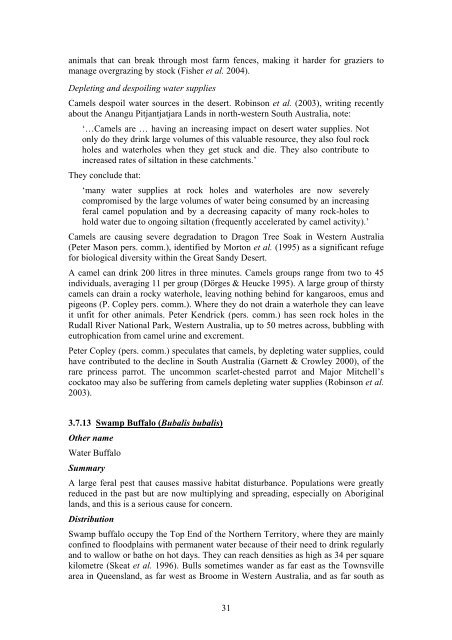Review of the management of feral animals and their impact on ...
Review of the management of feral animals and their impact on ...
Review of the management of feral animals and their impact on ...
Create successful ePaper yourself
Turn your PDF publications into a flip-book with our unique Google optimized e-Paper software.
<str<strong>on</strong>g>animals</str<strong>on</strong>g> that can break through most farm fences, making it harder for graziers to<br />
manage overgrazing by stock (Fisher et al. 2004).<br />
Depleting <str<strong>on</strong>g>and</str<strong>on</strong>g> despoiling water supplies<br />
Camels despoil water sources in <str<strong>on</strong>g>the</str<strong>on</strong>g> desert. Robins<strong>on</strong> et al. (2003), writing recently<br />
about <str<strong>on</strong>g>the</str<strong>on</strong>g> Anangu Pitjantjatjara L<str<strong>on</strong>g>and</str<strong>on</strong>g>s in north-western South Australia, note:<br />
‘…Camels are … having an increasing <str<strong>on</strong>g>impact</str<strong>on</strong>g> <strong>on</strong> desert water supplies. Not<br />
<strong>on</strong>ly do <str<strong>on</strong>g>the</str<strong>on</strong>g>y drink large volumes <str<strong>on</strong>g>of</str<strong>on</strong>g> this valuable resource, <str<strong>on</strong>g>the</str<strong>on</strong>g>y also foul rock<br />
holes <str<strong>on</strong>g>and</str<strong>on</strong>g> waterholes when <str<strong>on</strong>g>the</str<strong>on</strong>g>y get stuck <str<strong>on</strong>g>and</str<strong>on</strong>g> die. They also c<strong>on</strong>tribute to<br />
increased rates <str<strong>on</strong>g>of</str<strong>on</strong>g> siltati<strong>on</strong> in <str<strong>on</strong>g>the</str<strong>on</strong>g>se catchments.’<br />
They c<strong>on</strong>clude that:<br />
‘many water supplies at rock holes <str<strong>on</strong>g>and</str<strong>on</strong>g> waterholes are now severely<br />
compromised by <str<strong>on</strong>g>the</str<strong>on</strong>g> large volumes <str<strong>on</strong>g>of</str<strong>on</strong>g> water being c<strong>on</strong>sumed by an increasing<br />
<str<strong>on</strong>g>feral</str<strong>on</strong>g> camel populati<strong>on</strong> <str<strong>on</strong>g>and</str<strong>on</strong>g> by a decreasing capacity <str<strong>on</strong>g>of</str<strong>on</strong>g> many rock-holes to<br />
hold water due to <strong>on</strong>going siltati<strong>on</strong> (frequently accelerated by camel activity).’<br />
Camels are causing severe degradati<strong>on</strong> to Drag<strong>on</strong> Tree Soak in Western Australia<br />
(Peter Mas<strong>on</strong> pers. comm.), identified by Mort<strong>on</strong> et al. (1995) as a significant refuge<br />
for biological diversity within <str<strong>on</strong>g>the</str<strong>on</strong>g> Great S<str<strong>on</strong>g>and</str<strong>on</strong>g>y Desert.<br />
A camel can drink 200 litres in three minutes. Camels groups range from two to 45<br />
individuals, averaging 11 per group (Dörges & Heucke 1995). A large group <str<strong>on</strong>g>of</str<strong>on</strong>g> thirsty<br />
camels can drain a rocky waterhole, leaving nothing behind for kangaroos, emus <str<strong>on</strong>g>and</str<strong>on</strong>g><br />
pige<strong>on</strong>s (P. Copley pers. comm.). Where <str<strong>on</strong>g>the</str<strong>on</strong>g>y do not drain a waterhole <str<strong>on</strong>g>the</str<strong>on</strong>g>y can leave<br />
it unfit for o<str<strong>on</strong>g>the</str<strong>on</strong>g>r <str<strong>on</strong>g>animals</str<strong>on</strong>g>. Peter Kendrick (pers. comm.) has seen rock holes in <str<strong>on</strong>g>the</str<strong>on</strong>g><br />
Rudall River Nati<strong>on</strong>al Park, Western Australia, up to 50 metres across, bubbling with<br />
eutrophicati<strong>on</strong> from camel urine <str<strong>on</strong>g>and</str<strong>on</strong>g> excrement.<br />
Peter Copley (pers. comm.) speculates that camels, by depleting water supplies, could<br />
have c<strong>on</strong>tributed to <str<strong>on</strong>g>the</str<strong>on</strong>g> decline in South Australia (Garnett & Crowley 2000), <str<strong>on</strong>g>of</str<strong>on</strong>g> <str<strong>on</strong>g>the</str<strong>on</strong>g><br />
rare princess parrot. The uncomm<strong>on</strong> scarlet-chested parrot <str<strong>on</strong>g>and</str<strong>on</strong>g> Major Mitchell’s<br />
cockatoo may also be suffering from camels depleting water supplies (Robins<strong>on</strong> et al.<br />
2003).<br />
3.7.13 Swamp Buffalo (Bubalis bubalis)<br />
O<str<strong>on</strong>g>the</str<strong>on</strong>g>r name<br />
Water Buffalo<br />
Summary<br />
A large <str<strong>on</strong>g>feral</str<strong>on</strong>g> pest that causes massive habitat disturbance. Populati<strong>on</strong>s were greatly<br />
reduced in <str<strong>on</strong>g>the</str<strong>on</strong>g> past but are now multiplying <str<strong>on</strong>g>and</str<strong>on</strong>g> spreading, especially <strong>on</strong> Aboriginal<br />
l<str<strong>on</strong>g>and</str<strong>on</strong>g>s, <str<strong>on</strong>g>and</str<strong>on</strong>g> this is a serious cause for c<strong>on</strong>cern.<br />
Distributi<strong>on</strong><br />
Swamp buffalo occupy <str<strong>on</strong>g>the</str<strong>on</strong>g> Top End <str<strong>on</strong>g>of</str<strong>on</strong>g> <str<strong>on</strong>g>the</str<strong>on</strong>g> Nor<str<strong>on</strong>g>the</str<strong>on</strong>g>rn Territory, where <str<strong>on</strong>g>the</str<strong>on</strong>g>y are mainly<br />
c<strong>on</strong>fined to floodplains with permanent water because <str<strong>on</strong>g>of</str<strong>on</strong>g> <str<strong>on</strong>g>the</str<strong>on</strong>g>ir need to drink regularly<br />
<str<strong>on</strong>g>and</str<strong>on</strong>g> to wallow or ba<str<strong>on</strong>g>the</str<strong>on</strong>g> <strong>on</strong> hot days. They can reach densities as high as 34 per square<br />
kilometre (Skeat et al. 1996). Bulls sometimes w<str<strong>on</strong>g>and</str<strong>on</strong>g>er as far east as <str<strong>on</strong>g>the</str<strong>on</strong>g> Townsville<br />
area in Queensl<str<strong>on</strong>g>and</str<strong>on</strong>g>, as far west as Broome in Western Australia, <str<strong>on</strong>g>and</str<strong>on</strong>g> as far south as<br />
31
















